How To Run Cuda Program In Windows
Installing Tensorflow with CUDA, cuDNN and GPU support on Windows ten
Pimp Up your PC for Deep Learning — Part two
In Part ane of this series, I discussed how you lot tin can upgrade your PC hardware to incorporate a CUDA Toolkit compatible graphics processing card, such as an Nvidia GPU. This Function 2 covers the installation of CUDA, cuDNN and Tensorflow on Windows 10. This article below assumes that you have a CUDA-uniform GPU already installed on your PC; but if you oasis't got this already, Office 1 of this series will aid yous get that hardware fix, ready for these steps.
Step ane: Check the software yous will need to install
Assuming that Windows is already installed on your PC, the additional bits of software yous will install every bit part of these steps are:-
- Microsoft Visual Studio
- the NVIDIA CUDA Toolkit
- NVIDIA cuDNN
- Python
- Tensorflow (with GPU back up)
Footstep 2: Download Visual Studio Express
Visual Studio is a Prerequisite for CUDA Toolkit
Visual studio is required for the installation of Nvidia CUDA Toolkit (this prerequisite is referred to here). If yous attempt to download and install CUDA Toolkit for Windows without having first installed Visual Studio, you lot get the message shown in Fig. 1.
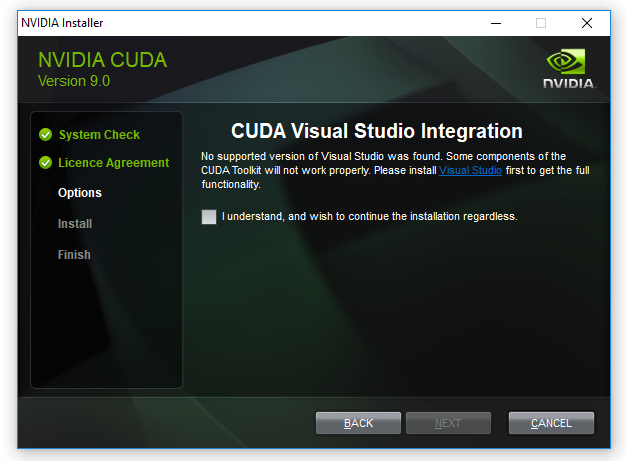
Selecting and downloading Visual Studio Express
At the time of writing, the most recent version of Visual Studio (which is free) is the Visual Studio Express Community Version 2017, shown in Fig 2. You can get previous versions of Visual Studio for free by joining "Visual Studio Dev Essentials" and and so searching for the version of Visual Studio you want.

Installing Visual Studio Express
One time you lot accept downloaded Visual Studio Limited, its installation is straightforward. Fig 3 shows the executable file you receive equally a download.
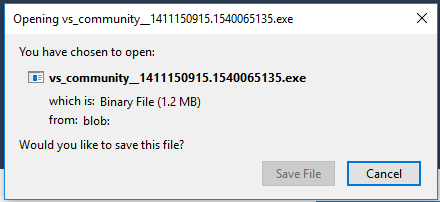
When you printing the 'save file' option on Fig 3, the window in Fig 4 volition appear where you tin set up installation options (or just leave them as they are past default, as I did).
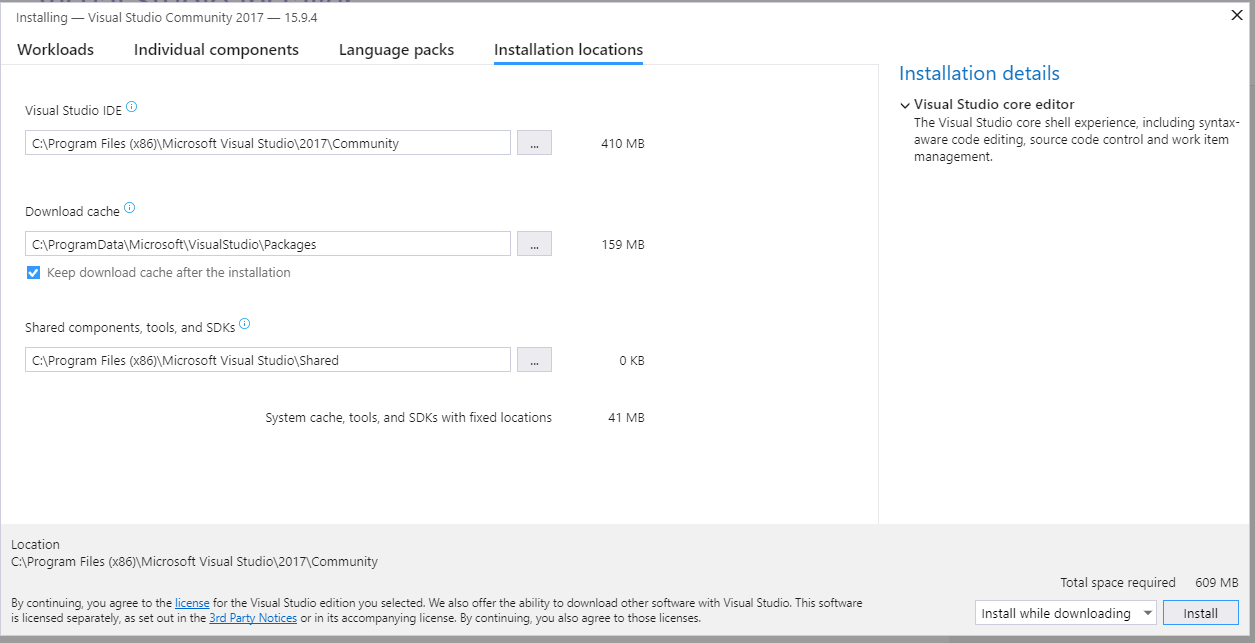
During installation, Visual Studio prompts you lot to as whether you 'desire to continue without workloads'. I pressed 'go on' hither, every bit I had no intention of using workloads at all.

A PC reboot after installation of Visual Studio May be Required
Later installing Visual Studio, I initially moved straight on to downloading and attempting to install CUDA Toolkit for Windows — that step is Step 3 which I will be describing adjacent. I got a message that Visual Studio was still operating and was preventing the installation of CUDA Toolkit. Rebooting my PC earlier attempting to install CUDA Toolkit over again solved this problem.
Step three: Download CUDA Toolkit for Windows 10
These CUDA installation steps are loosely based on the Nvidia CUDA installation guide for windows. The CUDA Toolkit (free) can be downloaded from the Nvidia website here.
At the fourth dimension of writing, the default version of CUDA Toolkit offered is version x.0, as shown in Fig 6. However, you lot should bank check which version of CUDA Toolkit you cull for download and installation to ensure compatibility with Tensorflow (looking ahead to Step 7 of this process). When you go onto the Tensorflow website, the latest version of Tensorflow available (ane.12.0) requires CUDA 9.0, non CUDA x.0. To notice CUDA nine.0, yous need to navigate to the "Legacy Releases" on the bottom right mitt side of Fig 6.
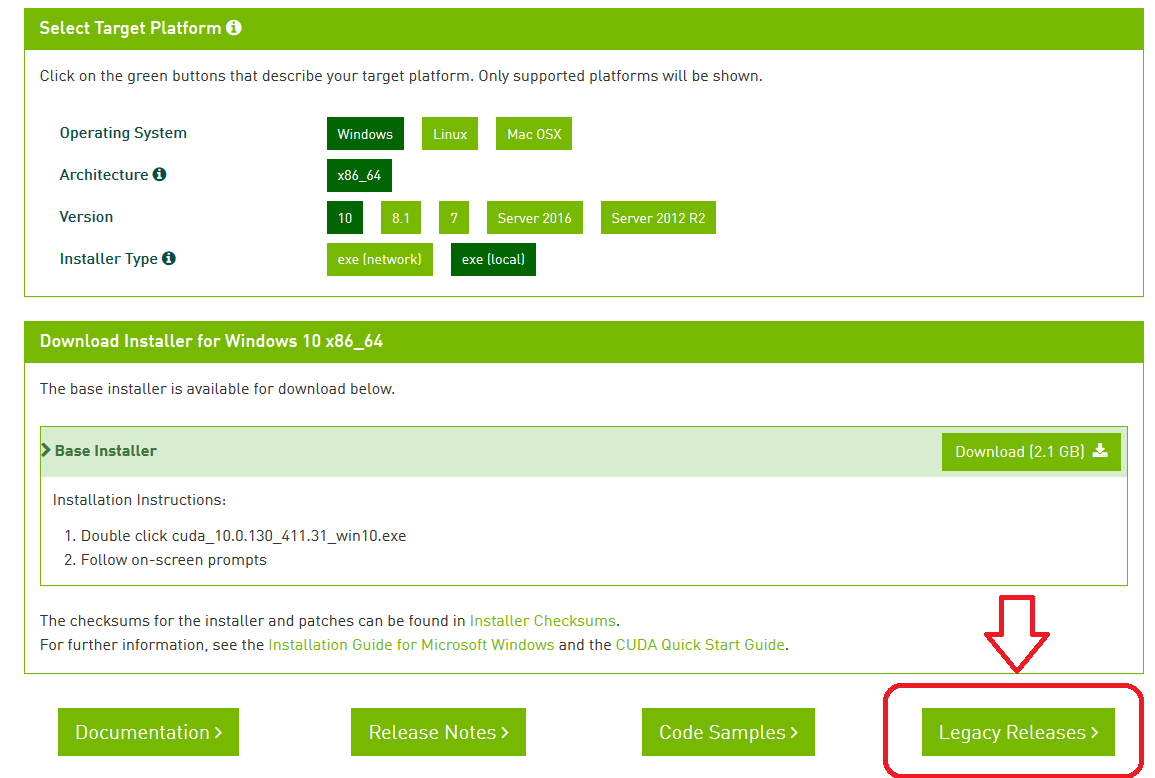
Stride 3.ane: Downloading CUDA 9.0 from the CUDA Toolkit Annal
Choosing "Legacy Releases" takes you to the CUDA Toolkit Annal. Based on Tensorflow installation guidance, the CUDA version required is 9.0, every bit listed in Fig 7.

Pace 3.two: Installing CUDA ix.0
CUDA 9.0 comes as a base installation and four patches; the base installation of CUDA 9.0 must be installed first, followed past the patches. The options for the base install which I selected are shown in Fig viii.
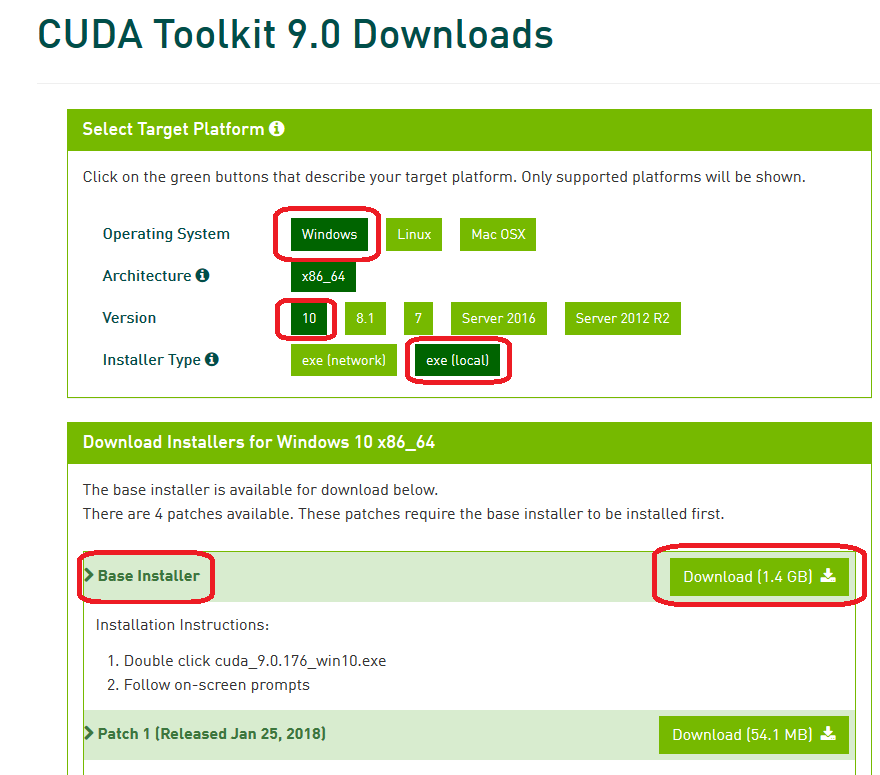
Running the base installer which has only been downloaded will produce the CUDA Setup Package window, equally shown in Fig 9.
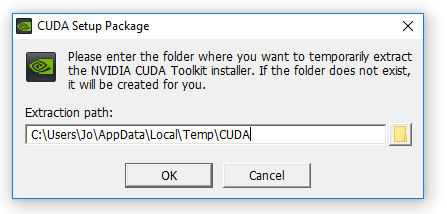
The CUDA installer extracts to your PC and, when consummate, the NVIDIA CUDA Toolkit installation will start; yous will get a bulletin to that issue. The resulting NVIDIA Installer windows throughout the installation procedure are shown at Fig ten — Fig thirteen. I chose the limited installation option (Fig. 10).

Fig. 11 provides the opportunity to select installation location; I chose the default locations provided, which for CUDA is :
C:\Plan Files\NVIDA GPU Computing Toolkit\CUDA\v9.0 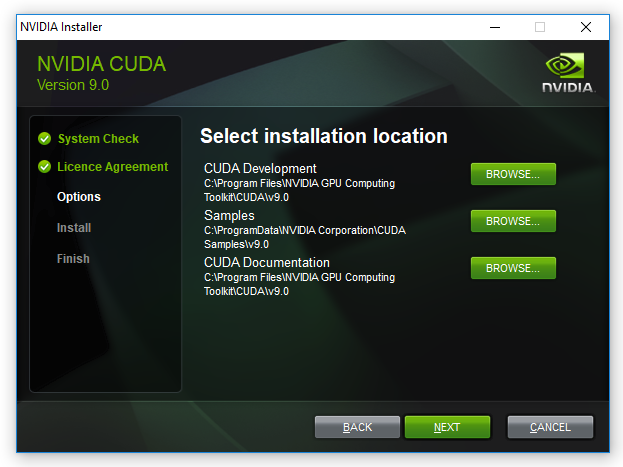
Fig. 12 below shows the CUDA installations which rely on Visual studio, previously installed in Step one.
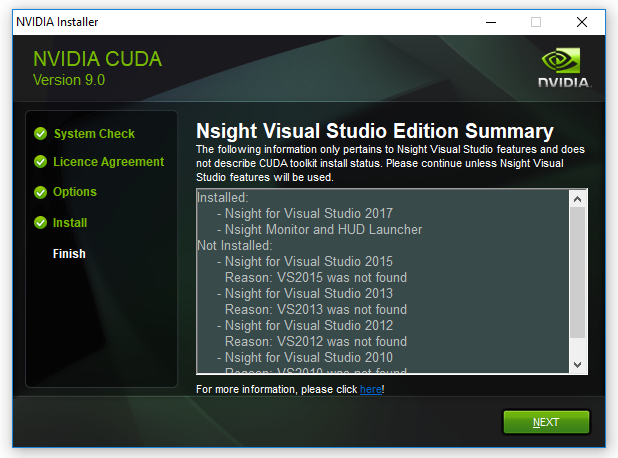
Pressing 'next' at the window shown in Fig. 12 above, gives the final installation window, shown every bit Fig.xiii below, where the NVIDIA installer is marked as finished.
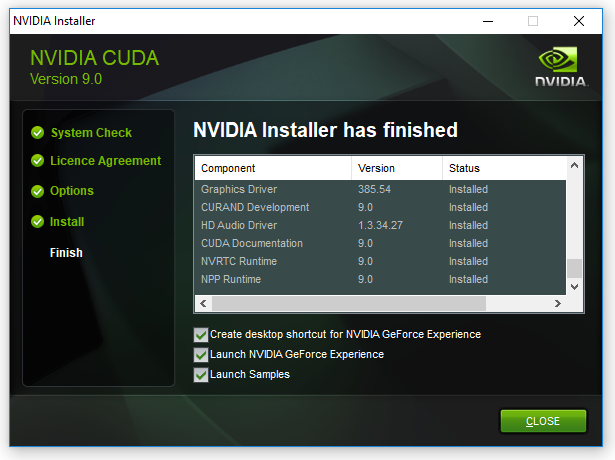
Step 4: Download Windows 10 CUDA patches
At the time of writing, there are iv CUDA patches to get (as well as the base installer), so let's go and download these. They are shown in Fig.14.

When the four patches are downloaded, they can be installed in the same way equally the base installer — with installation windows providing guidance through the procedure.
Pace 5: Download and Install cuDNN
Having installed CUDA 9.0 base installer and its four patches, the next stride is to discover a compatible version of CuDNN. Based on the information on the Tensorflow website, Tensorflow with GPU support requires a cuDNN version of at least 7.2.
Step 5.1: Downloading cuDNN
In lodge to download CuDNN, you lot have to register to become a member of the NVIDIA Developer Plan (which is free).

When you create an account, login and fill out some other required details almost why you are using the account, yous get the download page shown in Fig. sixteen.
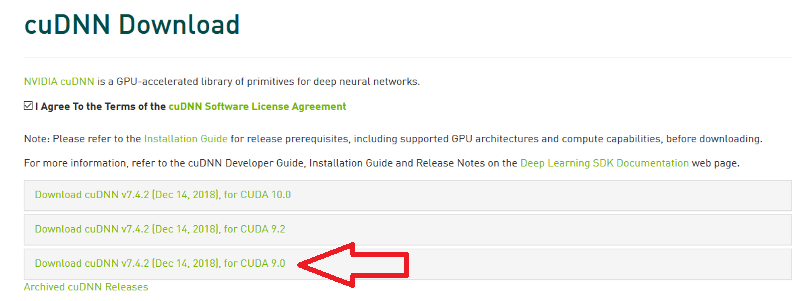
As I have downloaded CUDA nine.0, the corresponding version of cuDNN is version seven.iv.2. Choosing cuDNN version vii.4.ii enables the download equally a zip file named as follows:
cudnn-ix.0-windows10-x64-v7.cypher Step 5.2: Unzipping cuDNN files and copying to CUDA folders
Instructions at Nvidia provide support for windows cuDNN installation, as practice instructions on the Tensorflow website ; I accept reproduced these instructions in distilled form, based on my implementation of them. In my case, I downloaded the cuDNN .zip file named above into a folder which has the following path on my PC (your path will no incertitude exist different).
C:\Users\jo\Documents\cuDNN_downloads\ In the instructions below, I refer to the folder path " C:\Users\jo\Documents\cuDNN_downloads\" (referred to just above) equally "<downloadpath>", such that the cipher file is at present in the path:
<downloadpath>\cudnn-9.0-windows10-x64-v7.five.0.56.nothing I unzipped the cuDNN ".null" file where I downloaded it, hence the unzipped binder structure which will comprise the required cuDNN files is now:-
<downloadpath>\cudnn-ix.0-windows10-x64-v7.5.0.56\ There are three files in the unzipped cuDNN folder subdirectories which are to exist copied into the CUDA Toolkit directories. These are cudnn64_7.dll, cudnn.h and :
i. cudnn64_7.dll
cudnn64_7.dll can exist found in the following path inside the downloaded cuDNN files:
<downloadpath>\cudnn-9.0-windows10-x64-v7.five.0.56\cuda\bin\cudnn64_7.dll Assuming that you installed CUDA nine.0 to its default path (every bit I did at Step ii.3), namely the post-obit default path:
C:\Program Files\NVIDA GPU Calculating Toolkit\CUDA\v9.0 you can copy the cudnn64_7.dll file directly into the CUDA folder'south bin folder path (annotation: yous don't need to create any new subfolders):
C:\Programme Files\NVIDIA GPU Calculating Toolkit\CUDA\v9.0\bin\ 2. cudnn.h
Equally with the cudnn64_7.dll file above, after downloading and unzipping the cuDNN folder, the header file cudnn64.h tin can exist found in the path:
<downloadpath>\cudnn-9.0-windows10-x64-v7.5.0.56\cuda\ include\cudnn.h Over again, bold that you installed CUDA nine.0 into the default path as I did at Stride ii.3, copy cudnn.h directly into the CUDA folder with the following path (no new subfolders are necessary):
C:\Programme Files\NVIDIA GPU Calculating Toolkit\CUDA\v9.0\include\ iii. cudnn.lib
The .lib file cudnn.lib tin can be found in the downloaded cuDNN path:
<downloadpath>\cudnn-ix.0-windows10-x64-v7.five.0.56\cuda\lib\x64\cudnn.lib Re-create cudnn.lib directly into the CUDA folder with the post-obit path:
C:\Program Files\NVIDIA GPU Computing Toolkit\CUDA\v9.0\lib\x64\ Footstep 5.3: Checking CUDA surroundings variables are set in Windows
Finally, the instructions at Nvidia straight that you lot ensure that the CUDA environs variable has previously been set upwards, every bit follows:
Variable Proper noun: CUDA_PATH
Variable Value: C:\Program Files\NVIDIA GPU Calculating Toolkit\CUDA\v9.0 In Windows x, the Environment Variables can be found by choosing:
Control Panel ->System and Security->System->Avant-garde System settings.
This opens up a window chosen "Organisation Backdrop" (Fig 17), at which point the "Environment Variables" button should be chosen.
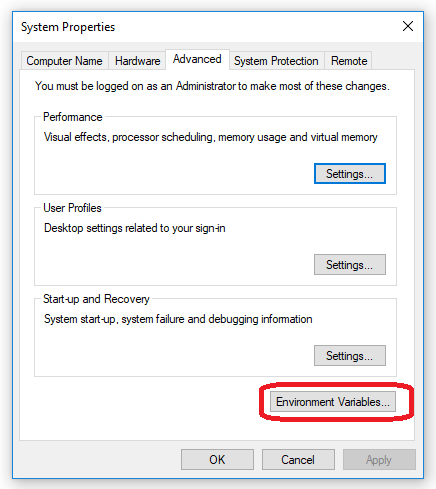
When the Environs Variables window then appears, within "arrangement variables" (in the bottom half of the window), click on "Path" and choose the button "edit". A new window will appear, called "Edit environment variable" as shown in Fig xviii below.
On checking the Surround Variables, I found the installation process which determines the CUDA installation path — Step 3.2, see Fig. 11 — had already added ii paths to CUDA . These paths are shown in Fig 18 below, so I establish I did not need to add a further CUDA path.
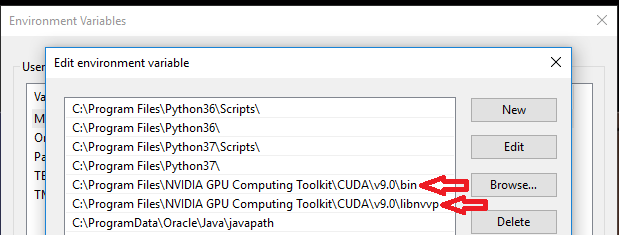
Step 6: Install Python (if you don't already take information technology)
At present that CUDA and cuDNN are installed, information technology is time to install Python to enable Tensorflow to be installed later on. At the time of writing, the virtually up to date version of Python three bachelor is Python 3.7, but the Python iii versions required for Tensorflow are 3.four, three.five or 3.half dozen. Python 3.6 can be downloaded for Windows 10 from here. When you run the Python installer for windows, the setup window in Fig nineteen will appear.
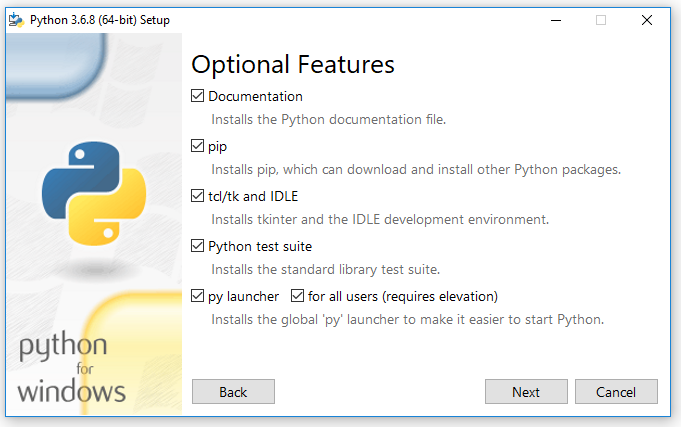
Of the options in Fig. 19 above during Python installation, I chose to select all of them. These options are useful: Python's 'pip' installer is used at Step vii.2 of this guide to install Tensorflow. Additionally, I use the IDE (integrated development environment for writing and running python code) chosen "IDLE" at Step viii.
In the "Advanced Options" (shown at Fig 20 below), I chose the installation of Python for all users (which was not ticked by default); this gives the more useful system wide installation.
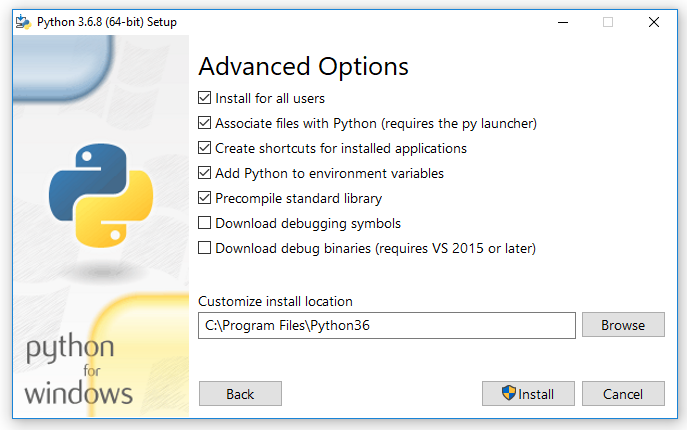
Stride vii: Install Tensorflow with GPU support
Tensorflow provides instructions for checking that CUDA, cuDNN and (optional: CUPTI) installation directories are correctly added to the PATH environmental variables. As the three cuDNN files were copied into the subfolders of CUDA, I did non update the existing CUDA environmental variables path.
Step 7.one: Calling up the command prompt with administration rights
In this footstep a system-wide install of Tensorflow is carried out, non a per user install. System wide installation of Tensorflow requires authoritative rights, therefore, accordingly the command prompt should exist run with administrative rights.
Open up the command prompt by running 'cmd' in the search bar, and then right clicking on command prompt to choose 'run as ambassador'. This opens up Ambassador: Command Prompt every bit shown in Fig 21.
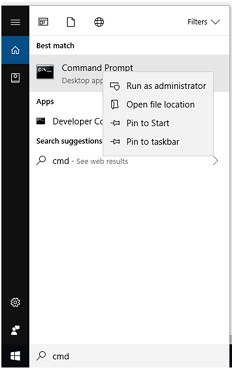
Step seven.ii: System wide install of Tensorflow via python pip
Having opened the Command Prompt, the system-wide installation command for Tensorflow with GPU support is every bit follows:
pip3 install --upgrade tensorflow-gpu The "pip3" command (as opposed to "pip") is required as the installation is to Python 3. Execution of this command in the command prompt is shown in Fig 22.

The resulting output from the control is shown in Fig 23, and if all goes to program there should somewhen be a bulletin to confirm that Tensorflow has been installed successfully.
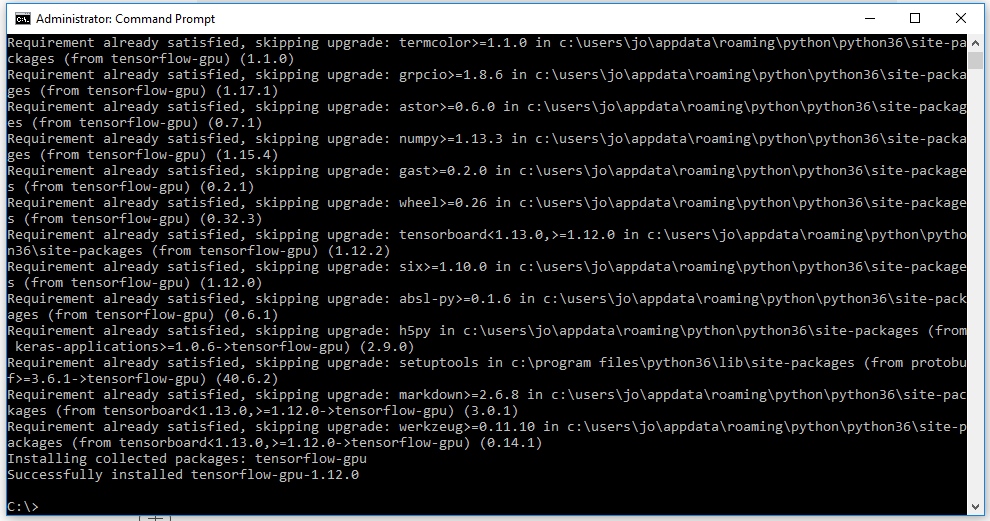
Stride 8: Test Installation of TensorFlow and its access to GPU
Go to the start menu in windows and search for the IDE called 'idle', which will be installed every bit part of your python installation if you selected equally I did at Stride vi. A Python window should appear labelled Python iii.6.x Crush . At the prompt (denoted by '>>>'), import the Tensorflow package. This will check that Tensorflow has been installed (as you lot tin import it). The control for the IDLE shell to import the tensorflow packet is as follows:
# importing the tensorflow bundle
import tensorflow every bit tf To test CUDA support for your Tensorflow installation, you can run the following command in the shell:
tf.test.is_built_with_cuda() Finally, to confirm that the GPU is available to Tensorflow, you tin can test using a built-in utility role in TensorFlow as shown here:
tf.test.is_gpu_available(cuda_only=Simulated, min_cuda_compute_capability=None) It takes a few minutes to return a result from this; when it is finished it returns True , and so the prompt `>>>`appears once more. Importing tensorflow and these tests are all shown in Fig 24 in the Python IDLE Shell.
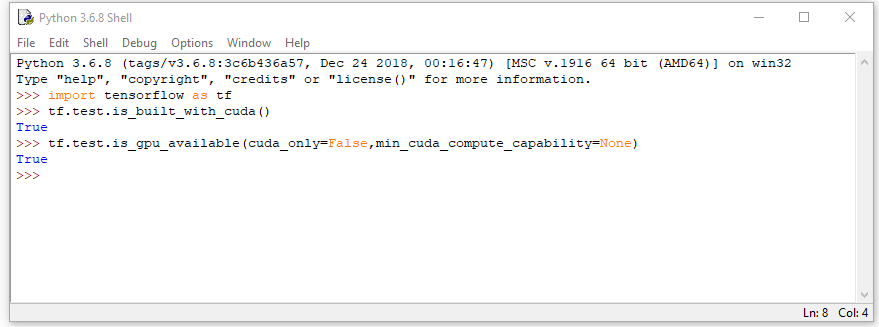
Conclusions
These were the steps I took to install Visual Studio, CUDA Toolkit, CuDNN and Python 3.6, all with the ultimate aim of installing Tensorflow with GPU back up on Windows 10. To date, my GPU based machine learning and deep learning work has been on Linux Ubuntu machines; past the same token, much of the machine learning customs support online focuses on Ubuntu.
For Machine Learning, the major drawback to using Windows is that it is necessary to build more things from source (for case using Cmake) than on Linux, and also to install additional software for the build processes, such as Visual Studio. For example, if you were to install Caffe2 on Windows, at that place are no pre-congenital binaries and Windows build is in testing and beta mode. I installed CUDA and cuDNN on Windows 10 more out of curiosity than anything else, just to see how straightforward (or otherwise) information technology was.
As I intimated in Part 1, now that CUDA, cuDNN and Tensorflow are successfully installed on Windows x and I have checked Tensorflow's access to GPU, I am going to sweep the whole Windows 10 operating system away in order to make a fresh installation of Ubuntu 18.04 LTS. This new installation of Ubuntu will be covered in Part 3 of this series.
This article has as well been published here on my ain web log.
Source: https://towardsdatascience.com/installing-tensorflow-with-cuda-cudnn-and-gpu-support-on-windows-10-60693e46e781
Posted by: mcgonaglethemisside.blogspot.com

0 Response to "How To Run Cuda Program In Windows"
Post a Comment